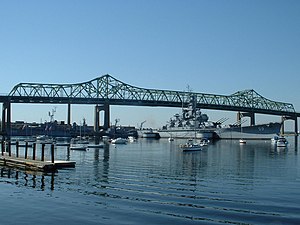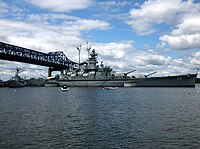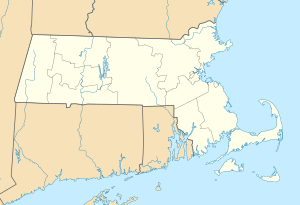USS Massachusetts (BB-59)
 Massachusetts off the coast of Point Wilson, Washington
| |
| History | |
|---|---|
| Ordered | 15 December 1938 |
| Builder | Bethlehem Steel Corporation (Fore River Shipyard) |
| Laid down | 20 July 1939 |
| Launched | 23 September 1941 |
| Commissioned | 12 May 1942 |
| Decommissioned | 27 March 1947 |
| Stricken | 1 June 1962 |
| Nickname(s) | "Big Mamie" |
| Status | Museum ship |
| General characteristics | |
| Class and type | Template:Sclass- battleship |
| Displacement | 35,000 tons |
| Length | 680.8 ft (207.5 m) |
| Beam | 108.2 ft (33.0 m) |
| Draft | 29.3 ft (8.9 m) |
| Speed | 27 knots (50 km/h; 31 mph) |
| Complement | 115 officers, 1,678 men |
| Armament | list error: <br /> list (help) 9 × 16 in (410 mm)/45 caliber Mark 6 guns 20 × 5 in (130 mm)/38 cal guns 24 × Bofors 40 mm guns 35 × Oerlikon 20 mm cannons |
USS Massachusetts (BB-59) | |
 Massachusetts at Battleship Cove | |
| Location | 5 Water Street, Battleship Cove, Fall River, Massachusetts |
|---|---|
| Built | 1941 |
| Architect | US Navy |
| NRHP reference No. | 76002269[1] |
| Significant dates | |
| Added to NRHP | 30 September 1976[1] |
| Designated NHL | 14 January 1986[2] |
USS Massachusetts (BB-59), known as "Big Mamie" to her crewmembers during World War II, was a battleship of the second South Dakota class. She was the seventh ship of the United States Navy to be named in honor of the sixth state, and one of two ships of her class (along with her sister Alabama) to be donated for use as a museum ship. Among the ships armed with 16-inch (410 mm) guns during World War II, Massachusetts stands out because it is believed that she fired the US Navy's first and last 16 in (410 mm) shells of the war.[3]
During World War II Massachusetts was initially assigned to duty in the Atlantic Fleet, and exchanged shots with the Vichy French battleship Jean Bart during Operation Torch. Transferred to the Pacific fleet in 1943, Massachusetts participated in the Solomon Islands campaign and the Philippines Campaign, and in the latter campaign took part in the Battle of Leyte Gulf. In 1945 she was one of several ships assigned to shell targets on Honshū, the largest of the Japanese Home Islands. Following the end of World War II, Massachusetts was involved in routine operations off the US coast and eventually reassigned to the Atlantic fleet. Decommissioned in 1947, she was laid up in the reserve fleet at Norfolk, Virginia until stricken from the Naval Vessel Register in 1962.
In an effort to spare the battleship from scrapping, citizens of Massachusetts pooled resources to raise money for her transfer to the Massachusetts Memorial Committee, and in 1965 the Navy formally donated the battleship to the committee. Massachusetts was towed to Battleship Cove, Fall River, Massachusetts, and formally opened as a museum ship on 14 August 1965.
Construction
Massachusetts was one of four fast battleships of the South Dakota class to be authorized for construction by the United States Congress in 1938. Her keel was laid down on 20 July 1939 at the Fore River Shipyard of Quincy, Massachusetts.[4] She was launched on 23 September 1941 sponsored by Mrs. Charles Francis Adams, wife of a former Secretary of the Navy. She was commissioned on 12 May 1942 at Boston, Massachusetts, Captain Francis E. M. Whiting in command.[5]
Massachusetts's main battery consisted of nine 16 in (410 mm)/45 caliber Mark 6 guns in three triple turrets (three in a superfiring turret forward, the third turret mounted aft of the main superstructure)[clarification needed] that were capable of firing 2,700-pound (1,200 kg) armor-piercing (AP) Mark 8 shells.[6] Her secondary battery consisted of twenty 5"/38 caliber guns, which could hit targets up to 9 miles (14 km) away. For defense against air strikes, Massachusetts was fitted with an anti-aircraft (AA) battery of 0.50 cal machine guns and 1.1"/75 caliber guns. With a wholesale shift to air power at the dawn of World War II came the imperative to gain and maintain air superiority in order to protect the growing fleet of Allied aircraft carriers. By the end of the war Massachusetts sported an array of Oerlikon 20 mm and quadruple Bofors 40 mm anti-aircraft guns.[7]
Atlantic operations
After a shakedown cruise, Massachusetts set sail from the United States on 24 October 1942. Four days later she joined a task force forming to support the invasion of North Africa, where she served as the flagship for Admiral Henry Kent Hewitt during Operation Torch.[5]
Early in the morning on 8 November the Naval Battle of Casablanca began. Lying off the city, Massachusetts, the heavy cruisers Tuscaloosa and Wichita and four destroyers, came under fire from four 194 mm (7.6 in) and four 138 mm (5.4 in) guns in a shore battery at El Hank. The American ships responded by shelling Jean Bart, an incomplete French battleship forced to sail from Saint-Nazaire in May 1940 to escape advancing Nazi forces. When engaged, Jean Bart had only one of her two quadruple turrets installed, the other and half its guns had been lost to torpedo attack while in shipment from France.[8]
Massachusetts began firing at 07:04 at a range of 22,000 m (72,000 ft); she continued until 08:33 with a seven-minute halt from 07:40 to 07:47. A total of nine full broadsides and thirty-eight volleys varying between three and six guns were fired, five rounds hit Jean Bart. One, at 08:06, disabled her operational turret, others struck docks and merchant ships, sinking two.[9]
With the help of the heavy cruiser Tuscaloosa, Massachusetts next targeted French destroyers in the fray, sinking Fougueux and Boulonnais as well as the light cruiser Primauguet. Along with shore batteries, she shelled an ammunition dump. Massachusetts was hit twice by the battery at El Hank, but sustained only superficial damage.[5] By the end of the engagement she had fired 786 of the 800 rounds of 16 inch ammunition she carried, or 98% of her complement.[6]
After a cease-fire, she headed for the United States on 12 November and prepared for deployment to the Pacific.
Pacific war
Massachusetts arrived at Nouméa, New Caledonia on 4 March 1943. For the next few months, she operated in the South Pacific, protecting convoy lanes and supporting operations in the Solomon Islands. From 19–21 November, she sailed with an aircraft carrier group striking Makin, Tarawa, and Abemama in the Gilbert Islands; on 8 December, she shelled Japanese positions on Nauru.

The Navy now drove steadily across the Pacific. On 30 January 1944, Massachusetts bombarded Kwajalein, and she covered the landings there on 1 February. With a carrier group she struck against the Japanese stronghold at Truk on 17 February. That raid not only inflicted heavy damage on Japanese aircraft and naval forces, but also proved to be a stunning blow to enemy morale. On 21–22 February, Massachusetts helped fight off a heavy air attack on her task group while it made raids on Saipan, Tinian, and Guam. She took part in the attack on the Caroline Islands in late March and participated in the landing of US troops at Hollandia on 22 April. Upon retiring from Hollandia, Massachusetts and the other ships of Task Force 38 (TF 38) staged another attack on Truk.[5]
Massachusetts shelled Ponape Island on 1 May, her last mission before sailing to Puget Sound to overhaul and reline her gun barrels, now well-worn. On 1 August, she left Pearl Harbor to resume operations in the Pacific war zone. She departed the Marshall Islands on 6 October, sailing to support the landings in Leyte Gulf. In an effort to block Japanese air attacks in the Leyte conflict, she participated in a fleet strike against Okinawa on 10 October. From 12–14 October she screened Allied forces while they struck Formosa. While part of Task Group 38.3 (TG 38.3) she took part in the Battle for Leyte Gulf from 22–27 October, during which planes from her group sank four Japanese carriers off Cape Engaño. After having stopped briefly at Ulithi, Massachusetts returned to the Philippines as part of TF 38 which struck Manila on 14 December.[5]
On 18 December 1944 Massachusetts and the other ships of TF 38 unexpectedly found themselves in a fight for their lives when Typhoon Cobra overtook the force. At the time of the typhoon Massachusetts was sailing with the Third Fleet's Task Group 38.1 and reported one injured sailor[10] and two planes lost as a result of the typhoon.[11]

From 30 December–23 January 1945, she sailed as part of TF 38, which struck Formosa and supported the landing at Lingayen. During that time she turned into the South China Sea, where TF 38 destroyed shipping from Saigon to Hong Kong; the operation concluded with air strikes on Formosa and Okinawa.[5]
From 10 February – 3 March, with the 5th Fleet, Massachusetts guarded carriers during raids on Honshū. Her group also struck Iwo Jima by air for the invasion of that island. On 17 March, the carriers launched strikes against Kyūshū while Massachusetts fired in repelling enemy attacks,[clarification needed] splashing several planes. Seven days later, she bombarded Okinawa. She spent most of April fighting off air attacks, while engaged in the operations at Okinawa, returning to the area in June, when she passed through the eye of a typhoon with 100 knots (190 km/h; 120 mph) winds on 5 June. She bombarded Minami Daito Jima in the Ryukyu Islands on 10 June.[5]
Massachusetts sailed on 1 July from Leyte Gulf to join the Third Fleet's final offensive against Japan. After protecting carriers that launched strikes against Tokyo, she formed part of a force that, on 14 July, shelled Kamaishi, Honshū, Japan's second largest iron and steel center. Two weeks later, she bombarded the industrial complex at Hamamatsu before she returned to blast Kamaishi on 9 August. It was here that Massachusetts fired what was probably the last 16 in (410 mm) shell fired in combat in World War II.[5]
Post-war – Museum ship

After the war, Massachusetts sailed for Puget Sound and overhaul 1 September. She left there 28 January 1946 for operations off the California coast, until leaving San Francisco, California, for Hampton Roads, arriving 22 April. She was decommissioned on 27 March 1947 to enter the Atlantic Reserve Fleet at Norfolk, Virginia, and was stricken from the Naval Vessel Register on 1 June 1962.[5] After being stricken, approximately 5,000 tons of equipment were stripped from Massachusetts for use on other naval vessels, including both of the explosively driven catapults used to launch float planes.[4]
"Big Mamie", as she was affectionately known, was saved from the scrap pile when veterans and citizens of the Commonwealth of Massachusetts, with the assistance of Massachusetts schoolchildren who raised $50,000 for her preservation, and was transferred to the non-profit Massachusetts Memorial Committee on 8 June 1965.[clarification needed] She was enshrined at Battleship Cove in Fall River, Massachusetts, on 14 August 1965, as the Bay State's memorial to those who gave their lives in World War II.[5]
In the 1980s, when the Reagan administration, as part of its "600-ship Navy" plan, recommissioned all four of the Template:Sclass-s, the U.S. Navy recovered large amounts of specialized equipment and spare parts that were still in storage aboard Massachusetts. Despite being used as a parts cache to get the Iowa-class battleships back in service, Massachusetts was added to the National Register of Historic Places and was designated a National Historic Landmark 14 January 1986.[2][12][13]
In November 1998, Massachusetts was closed to the public in advance of her planned departure for Boston, where she was scheduled to undergo an overhaul. She departed on her 300-mile (480 km) trip to the capital at 06:30 4 November 1998 with a tug boat moving her under the Braga, Mt. Hope and Newport Bridges, then up the coast to Boston. She arrived 7 November and entered Boston's Drydock Number 3, where an inspection determined the battleship was in need of additional steel plating along her hull at the water line to protect against sea water corrosion. In addition, the survey also located leaking rivets and identified a need to remove two of the battleship's propellers for repair purposes. For the next four months Massachusetts underwent repairs to correct these problems, including the addition of nearly 225,000 pounds (102,000 kg) of steel to her hull and the addition of a compound known as Red Hand Epoxy to encase and protect the hull against further deterioration. In March 1999 Massachusetts emerged from her dry docking period and returned under tow to Battleship Cove, arriving at her berth at 15:30 13 March 1999 to a crowd of citizens, dignitaries, veterans, and civic officials.[14]

Massachusetts is listed in good condition and she remains mostly unaltered, adhering to her World War II era configuration.[4] Former crewmembers have held reunions each year since the ship was decommissioned, with the 65th annual reunion taking place in June 2010.[15] Massachusetts is one of eight remaining US battleships that have been donated for use as museum ships; the other battleships are Alabama, Iowa, Missouri, New Jersey, North Carolina, Texas, and Wisconsin.[citation needed]
Awards and honors
Massachusetts received 11 battle stars for World War II service[5] as a result of her participation in operations in North Africa, the Gilbert, Carolina, and Marshall Islands campaigns, as well as operations during the battles for Leyte, Luzon, Iwo Jima, and Okinawa.[16] No US Navy sailors or Marines were killed in action aboard the battleship during the war.[citation needed]
See also
- U.S. Navy museums (and other battleship museums)
- List of museum ships
References
- ^ a b "National Register Information System". National Register of Historic Places. National Park Service. 9 July 2010.
- ^ a b "Massachusetts, USS (Battleship)", National Historic Landmarks Program, National Park Service, retrieved 12 August 2009
- ^ Turner 1997, p. 224.
- ^ a b c
Butowsky, Harry A., Dr. "Warships Associated with World War II in the Pacific: USS Massachusetts". National Maritime Initiative. National Park Service. Retrieved 1 August 2009.
{{cite web}}: CS1 maint: multiple names: authors list (link) - ^ a b c d e f g h i j k "Massachusetts". Dictionary of American Naval Fighting Ships. United States Navy. Retrieved 3 August 2009.
- ^ a b DiGiulian, Tony (22 October 2008). "United States of America 16"/45 (40.6 cm) Mark 6". NavWeaps Naval Weapons, Naval Technology and Naval Reunions. Retrieved 1 August 2009.
- ^ Garzke & Dulin 1980, p. 89.
- ^ Garzke & Dulin 1980, pp. 103–107.
- ^ Garzke & Dulin 1980, pp. 107–109.
- ^ "Pacific Typhoon, 18 December: Personnel Casualties Suffered by Third Fleet, 17–18 December 1944, Compiled from Official Sources". Naval History & Heritage Command. United States Navy. Retrieved 7 August 2009.
- ^ "Pacific Typhoon, 18 December 1944: Aircraft Losses Suffered by Third Fleet, 17–18 December 1944, Compiled From Official Sources". Naval History & Heritage Command. United States Navy. Retrieved 7 August 2009.
- ^ "Massachusetts (BB-59)". Naval Vessel Register. NAVSEA. 19 July 2002. Retrieved 7 August 2009.
- ^ Butowsky, Harry A. (May 1985). "National Register of Historic Places Inventory-Nomination: USS Massachusetts (BB 59)" (pdf). National Park Service. Retrieved 2012-10=06.
{{cite web}}: Check date values in:|accessdate=(help)
"Accompanying 10 photos, exterior and interior, from 1942, the 1970s, and 1984" (pdf). National Park Service. Retrieved 2012-10=06.{{cite web}}: Check date values in:|accessdate=(help) - ^ "Battleship Massachusetts at Dry Dock". U.S.S. Massachusetts Memorial Committee, Inc. Retrieved 10 August 2009.[dead link]
- ^ "Reunion for crew of battleship Massachusetts". Military Times. Associated Press. 12 June 2010. Retrieved 6 October 2012.
- ^ Turner 1997, p. 64.
- Bibliography
 This article incorporates text from the public domain Dictionary of American Naval Fighting Ships. The entry can be found here.
This article incorporates text from the public domain Dictionary of American Naval Fighting Ships. The entry can be found here.- Garzke, William H.; Dulin, Robert O. (1980). Battleships: Allied Battleships in World War II. Annapolis, Maryland: Naval Institute Press. ISBN 0-87021-100-5. OCLC 6355577.
{{cite book}}: Invalid|ref=harv(help) - USS Massachusetts (BB-59). Turner Publishing Company. 1997. pp. 64, 224. ISBN 1-56311-263-9. OCLC 38874740.
- Westwood, J. N. (1975) [1971]. "The Battleship". Fighting ships of World War II. London: Sidgwick & Jackson. ISBN 978-0-283-98287-3. OCLC 2090062.[clarification needed]
External links
- Battleship Cove museum site
- "USS Massachusetts (BB-59)". Historic Naval Ships Association.
- Maritimequest USS Massachusetts BB-59 Photo Gallery
- USS Massachusetts Photos on board the battleship USS Massachusetts (BB-59) in Fall River, Massachusetts
- Maritime History of Massachusetts, a National Park Service Discover Our Shared Heritage Travel Itinerary
- "Online Library of Selected Images: US Navy Ships: USS Massachusetts (BB-59), 1942–1965". Naval History & Heritage Command.
- Photo gallery of USS Massachusetts at NavSource Naval History no nationality or prefix;
- Use dmy dates from October 2012
- Existing battleships
- National Register of Historic Places in Massachusetts
- South Dakota-class battleships (1939)
- Ships built in Massachusetts
- 1941 ships
- World War II battleships of the United States
- United States Navy Massachusetts-related ships
- Museum ships in Massachusetts
- National Historic Landmarks in Massachusetts
- Buildings and structures in Fall River, Massachusetts
- Military and war museums in Massachusetts
- Museums in Bristol County, Massachusetts
- Ships on the National Register of Historic Places in Massachusetts
- Visitor attractions in Fall River, Massachusetts

